| Home | Diary | Flora | Fauna | Rugs | Dogs/Cats | Events |
| Smallholding 2016-24 | OFIYC 2013-15 | Farm Products/ Services | About |
| 2024 | 2025 |
| <<March 2024 | April 2024 | May 2024 >> |
|
||||||||||||||||||||||||
|
1st: A break in the weather Today has been sun, hail, rain and wind - we made the most of the blue sky when it appeared  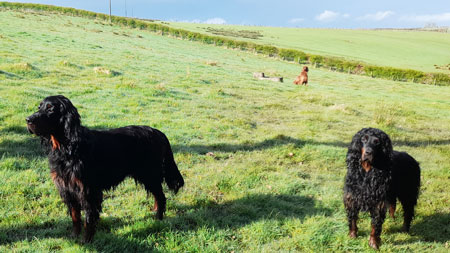 |
||||||||||||||||||||||||
|
2nd: Too cute Six week old pups asleep in the arms of Becky and Amy 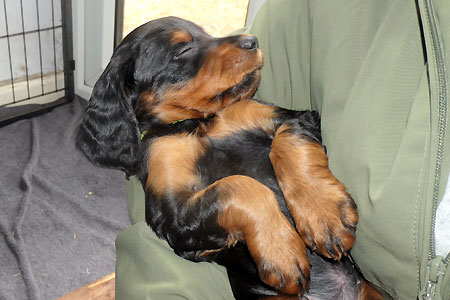  |
||||||||||||||||||||||||
|
3rd: Rewilding Today Becky, Kieran and Amy came over with a bag FULL of trees - oak, hornbeam and sweet chestnut - around 150 ish, all free thanks to Kieran (left over from a project via his work) These are destined to be planted in Oak field which we are now setting aside for rewilding and turning into more of a wooded area - we are beyond excited.  |
||||||||||||||||||||||||
|
4th: Lesser Celandine Lesser Celandine is filling our fields at the moment - plus the garden and hedgerows - a welcome sight as the rain continues to be the main feature of our daily weather.  |
||||||||||||||||||||||||
5th: Fabulous windy Moor walk |
||||||||||||||||||||||||
|
6th: Tree planting Today we managed to get around 140 trees planted at the bottom of Oak field. We have at least 100 left so the '150' we were given have obviously multiplied in the last few days!!! We have planted them in an arc coming out from the bottom corner and are keeping everything crossed that the 'expected' average loss of 10% is all we lose. We won't see a 'wood' in our lifetime but we should still see some pretty impressive growth nonetheless. We have helped by Lynn (Jack's old school friend) whilst her daughter Megan puppy-sat!! It was a tough job for her, obviously!!!     |
||||||||||||||||||||||||
|
7th: Woolley Animals Not our alpacas but a very gorgeous trio of boys from Woolley Animals who Jack, Lynn and Megan were privileged to walk around their fields, woods and lake! The mud under foot was a trifle wet but from above the weather was kind!!  |
||||||||||||||||||||||||
|
8th: Shearing and Pups Today we had our sheep shorn - much, much earlier than usual BUT this was because they were blade shorn by the amazing Michael Churchouse and as such a layer of wool was left on the sheep. The following is from an article Jack wrote on our friend Bec Briar who has been blade shearing her sheep for many years now. It explains what it is and why we do it this way. (Diana and Jeanette were with us for the day, so in between puppy cuddles, they got to witness this amazing process too.) 'Shearing is a huge welfare issue. Thanks to human intervention, the majority of sheep no longer self-shed and so it is imperative that once a year (twice for some breeds), we remove the previous year’s woolen growth. Not doing so leaves sheep prone to fly strike, injury, and illness as they have to move, eat and drink carrying dirty fleece and excess weight on their backs. The majority of sheep, and virtually all commercial sheep flocks, are shorn by mechanical clippers. These handheld (and surprisingly heavy) pieces of equipment remove the fleece at 'skin' level, something to be done 'on the rise' – i.e. at the time of year when the fleece is naturally starting to separate from the new wool coming through underneath. An experienced shearer can take off a whole fleece in under a minute – indeed, in many parts of the world, shearing is practised as both an occupation AND a sport with shearing competitions being a regular feature in the farming calendar. Whilst those fleeces need to come off from a welfare point of view, the ‘race’ to remove them is not perhaps quite so 'welfare-friendly'? A debate for another time!
Blade shearing is slower, but not much slower – and as such can be a much happier experience for sheep and shearer alike. The principle behind blade shearing is that the wool is not taken off at skin level, it is cut such that a layer of wool (2-3cms) is still left attached to the sheep. In Bec’s own words: 'Hand shearing leaves a layer of wool rich in lanolin on the animal which stops them being exposed to the elements. It is a slower process in which the shearer and sheep owner can take the time needed to look over the animals and check they are healthy and well. Blade shearing gives us a cleaner fleece with less lanolin and fewer second cuts. Blade shearing is also often done before lambing, again, a major difference compared to mechanical shearing which is usually done ‘after’ lambing. The biggest impact for the sheep is that many will be 'crutched' (shorn around their back ends) before lambing (to make the sheep cleaner and also to expose the udder for those hungry mouths) and then they will have to go through full shearing as well, often when still very full of milk, and with lambs a-foot that can get rather stressed as mum is taken away. Worse, sometimes, lambs and ewes then struggle to recognise each other when they are reunited!! Blade shearing before lambing means the ewes are ready to lamb with clean back ends and enough wool left on their backs to keep them warm and healthy AND they do not then have to go through the process again. The biggest impact of blade shearing though can be seen in the wool itself. 'Shearing before lambing' says Bec, 'means I then get a better fleece before it declines in quality as resources go to producing milk. It has more lustre and fewer 'breaks'.' Moreover, as the layer of wool left on the sheep is lanolin rich, less lanolin is produced as the new fleece grows back. Each year when Bec sends off some of her fleeces to be processed at her local mill, the percentage she gets back is greater due to there being less lanolin to wash out! As mentioned in my last article, lanolin can often account for around a third or more of the weight of a full fleece.'     |
||||||||||||||||||||||||
|
9th: Stanley and co Today we had a visit from Stanley and family - Stanley was Blue Boy from Roxy's first litter in 2020 and Sparrow's brother. He came with his pal Hector and another dog (whose name we cannot remember.. sorry) and what a time was had by all - there was a total of 12 humans and 18 dogs and we all got along just fine. We must just mention Dragonfly who became a besotted teenager when she saw Stanley - it was very, very sweet!!! Also of note is our new name for the two Irish - 'Red Stanleys' as named by one of Gill's grandchildren. We love it!!     |
||||||||||||||||||||||||
|
11th: Blackthorn and Willow We planted these willow in about our 3rd/ 4th year here so maybe four/five years ago. We have never trimmed it back nor did we plant the blackthorn in between - that simply established itself and we didn't cut it back. As part of our efforts to 'manage' the poultry area now we no longer have poultry in there, we will need to cut back some of the blackthorn a little but for now, it is providing a gorgeous display of blossom which is contrasting beautifully with the bright green of the new willow leaves.  |
||||||||||||||||||||||||
12th: Roxy, Otter and Firefly |
||||||||||||||||||||||||
|
14th: Feeding time The grass is growing but it's not in full spring mode yet so we are still feeding the sheep and alpacas. Plus Muckle and Bressay are still skinny and so need a bit extras for a while yet. We have in fact been giving them 2 feeds a day since shearing but feel now they should be ok with just one like the others. We really hope that their condition will improve slowly but surely now as we head towards the summer and the fact they won't need to go through the stress of being sheared again this year will ensure they are in a good state as we head towards next winter (not that we want to be thinking about next winter at all just now!!).    |
||||||||||||||||||||||||
16th: The gang of four's first day in the garden    |
||||||||||||||||||||||||
|
17th: Cuckoo flower and an Orange Tip butterfly This is we believe, an orange tip butterfly and whilst it is not resting on a Cuckoo flower (or Lady's smock), this is apparently, a flower it feeds from. As our fields are full of it right now, we hope to see a lot more of these butterflies!!   |
||||||||||||||||||||||||
|
18th: More tree planting We have now, we believe planted around 270 trees in Oak field. Today we planted rows of 3/4 alongside the bottom hedge as well as some around the field shelter. The ones we planted at the bottom of the field a week ago are looking great with swelling buds and in the case of the hornbeam, emerging leaves.   |
||||||||||||||||||||||||
|
19th: The Garden At last, the lawns are dry enough to mow - except the grass was way too tall for the mover so we (David) had to use the brushcutter. All looks very impressive mind you!    |
||||||||||||||||||||||||
|
20th: More strimming Today was the turn of the top lawns - we took one side each but made sure we left enough wild flowers and weeds to keep the wildlife happy!! 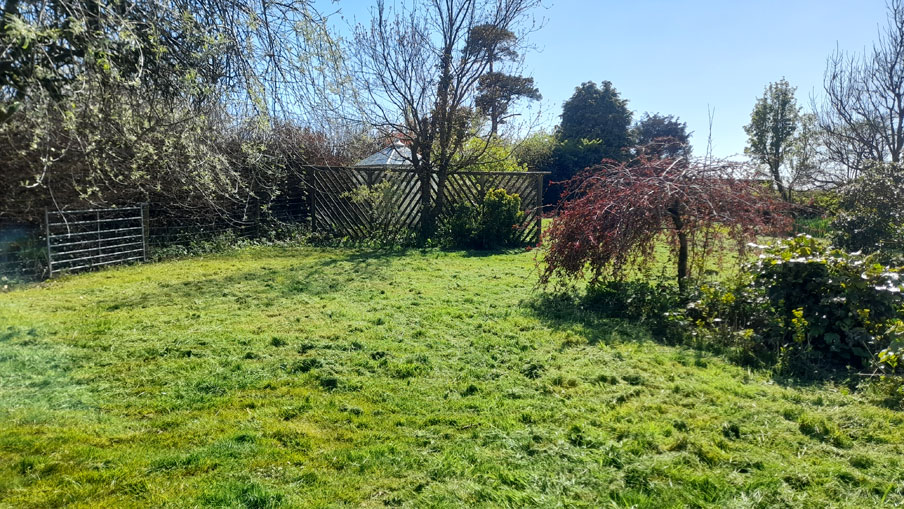  |
||||||||||||||||||||||||
|
21st: Enjoying the grass It's been a long winter for the goats. The rain has meant they have been inside a lot but finally drier weather and some very nice long grass in both the Viewing and Collecting Areas means they are now out and about. As they enjoy the grass, we will start to ease off their hard feed a bit! All three are in great condition and as more and more browsing becomes available, they should go from strength to strength!  |
||||||||||||||||||||||||
|
22nd: Gorse The gorse was so bright on the moor today. And what is our favourite wild flower question: 'In which month(s) does Gorse flower? Answer: All of them!!  |
||||||||||||||||||||||||
|
24th: Spring Every day is a day of discovery just now. The emerging tree leaves are from our newly planted whips in Oak field: Sweet Chestnut, Hornbeam and Oak and then we also have Cuckoo flowers which are our 'have to photograph every day' flowers along with dandelions - in full flower and in full seed dispersal mode, no wonder they are so successful at spreading!!        |
||||||||||||||||||||||||
|
25th: Watching the goats... ...which was obviously very tiring, that and playing zoomies with Otter!! See: Sparrow's Litter 
 |
||||||||||||||||||||||||
|
26th: Whalsay and Lemon We are so pleased that we have had the sheep shorn, and that they were blade shorn (see 7th). They are all looking great and now we don't have the worry of finding a shearer in May/ June who is free and able to shear just seven animals. We will no longer be wondering 'when' they are ready to shear, and we also won't be worrying they might be too hot with thick fleeces in the summer (not that 'hot' is a concept that we are familiar witjh just now). In addition, there should be a minimum risk of fly strike - not that we have had more than two cases in 15 years, but it is still something we look out for. So, all in all, we are very happy!! As our the sheep!!  |
||||||||||||||||||||||||
|
27th: Daisy Play Date Daisy spent the day with us today whilst Becky and Craig were in Bristol. She was a superstar with the sheep, goats and cats and our dogs had great fun playing chase with her and showing her the best places to dig!! And the puppies, as usual, adored her!   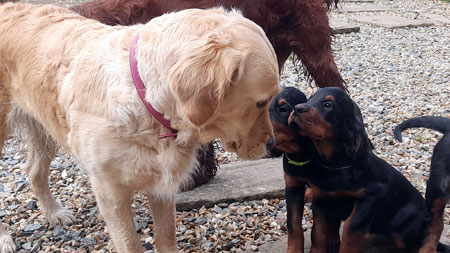  |
||||||||||||||||||||||||
|
29th: The Allotment Starting to look ready for the year!!!  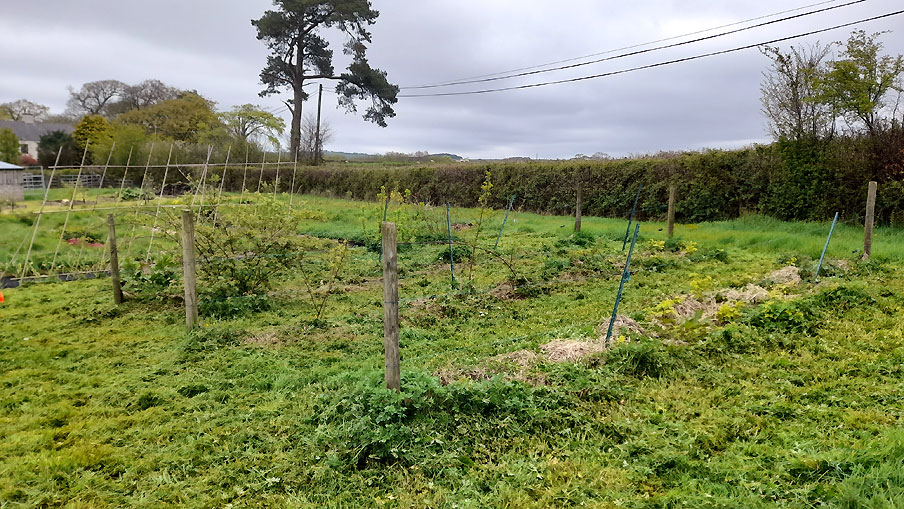 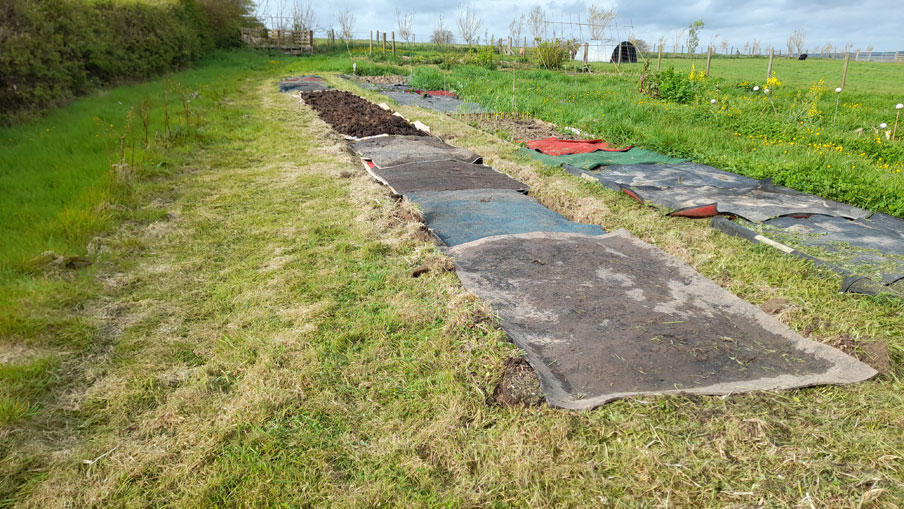 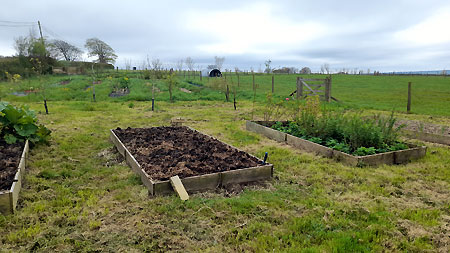  |
